News
Vol.82 April
- By utilizing the stable dispersion and optical nonlinearity of graphene, next-generation of optical material is expected.
- Semi-permanent graphene-dispersed photocurable colloid is expected to be used in laser protection, optical AI material, and optical sensors.

Korean researchers have succeeded in developing an innovative transparent film using graphene, a dream material. This development secures a new material technology that makes it easier to utilize new graphene materials, and it is expected to be widely used in fields such as lasers, optics, displays, and materials in the future.
Rresearchers at Electronics and Telecommunications Research Institute (ETRI) have developed a new transparent film that stably disperses graphene. The film’s transparency changes depending on the intensity of light, and is expected to be used in a variety of fields, including laser protection devices, smart optical sensors, and artificial intelligence (AI) photonic materials.
Graphene is attracting attention as a next-generation innovative material due to its excellent strength and electrical conductivity. However, it has been difficult to use in actual industries due to the problem of adhering together. Chemical dispersants were used to solve this problem, but it was difficult to keep the graphene’s properties intact.
 Principle of manufacturing graphene-dispersed photocured polymer composite materials
Principle of manufacturing graphene-dispersed photocured polymer composite materials
ETRI researchers have developed a new photocurable graphene-dispersed colloid1) and secured the technology to enable graphene to be stably and uniformly dispersed within a polymer without a dispersant. Based on this, it has become possible to easily manufacture graphene dispersed films and molds.
1) Colloid: A state in which a small solid material of 1 micron or less is dispersed in a liquid material
 Photocurable graphene colloid by concentration in the shape of black ink
Photocurable graphene colloid by concentration in the shape of black ink
 (Left) Graphene / polymer photocured composite material in the form of a film (thickness: 50 ㎛)
(Left) Graphene / polymer photocured composite material in the form of a film (thickness: 50 ㎛)
This graphene colloid is so stable that it can be stored for long periods of time, more than a year, without graphene precipitation. They also used light (UV) to convert the colloidal layer into a hard film, creating a new material that is easy to process while retaining the properties of graphene.
The researchers explained that the technology is environmentally friendly because the graphene-dispersed solution polymerizes to form the film and the entire graphene colloid is used to form the film, so no pollutants are generated. In addition, they explained that since it is a film manufacturing method employing light (UV) curing of the graphene colloid, it is advantageous for commercialization because it can be mass-produced in a continuous process, unlike conventional film-making methods that use molds or polymer solutions.
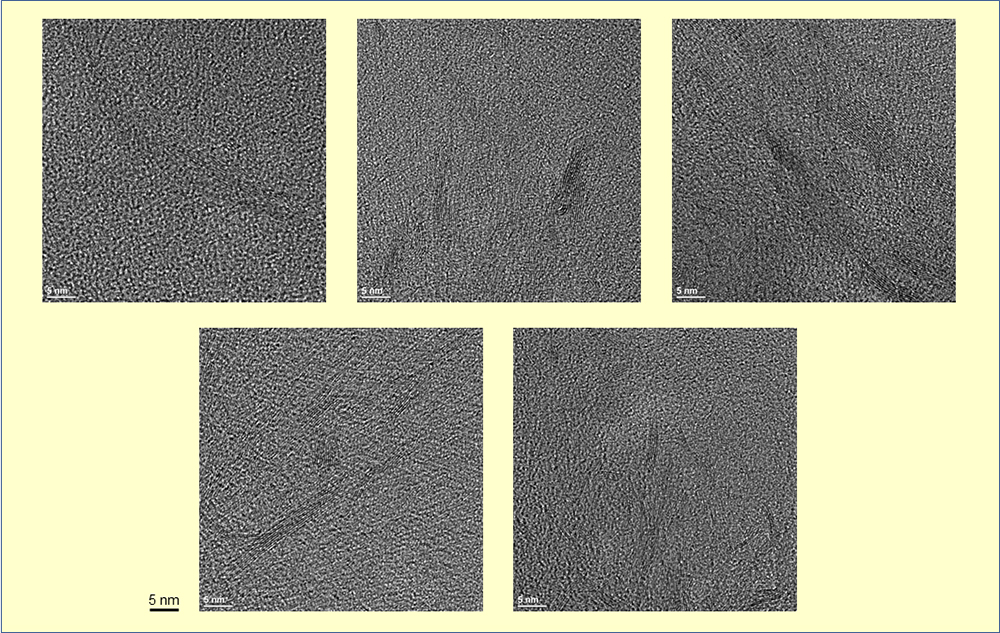 Graphene dispersion in photocured2) films by concentration
Graphene dispersion in photocured2) films by concentration
The developed graphene-dispersed photocurable transparent film can be applied in various industries such as optics, electronics, and AI by utilizing graphene’s unique light-regulating properties, or optical nonlinearity.
First, it can detect and block strong light, so it would be great as a laser sensor and protective film to protect your eyes or equipment. It is also expected to be applied to smart optical sensors that can control the intensity of light and detect changes to create more precise advanced sensors, and AI optical materials that AI uses to perform computations using light. Utilizing transparent and uniform films could also have significant implications for the development of high-performance displays and optical devices, the researchers said.
Shin Hyung Cheol, director of the Human Enhancement & Assistive Technology Research Section, said, “This research paves the way for easier utilization of graphene. It will be an innovative material, especially in optical-related components and AI applications.”
ETRI researchers plan to continue further research to develop more precise and efficient optical and electronic materials by utilizing graphene’s diverse properties. They are also working with related companies to consider cooperation regarding commercialization research and mass production systems.
The ETRI research team published the results of this study in March in 『Composites Part A: Applied Science and Manufacturing』, a materials science journal published by Elsevier, an internationally authoritative academic publisher, and applied for a domestic patent for the related technology.
This work was supported by the Institute of Information & communications Technology Planning & Evaluation (IITP) grant funded by the Korea government (MSIT) (No.2021-0-00019, Research on Optical Learning Technology for AI).
2) Photocure: The transformation of a liquid substance into a solid when illuminated by light
Park Seung Koo, Principal Researcher
Human Enhancement & Assistive Technology Research Section
(+82-42-860-5162, skpark@etri.re.kr)
- 5 key technologies on display, including an intelligent OTT player offering multi-view capabilities
- Showcasing hyper-realistic media breakthroughs on the global stage
Korean researchers have unveiled next-generation core technologies for broadcasting and media, powered by artificial intelligence (AI), at the world’s largest exhibition held in the United States. These technologies are expected to accelerate innovation across the media and broadcasting industries and further strengthen Korea’s leadership in the global market.
Electronics and Telecommunications Research Institute (ETRI) showcased the latest broadcasting and media technologies, developed by its researchers, at NAB 2025—the world’s largest international broadcasting equipment exhibition1)—held at the Las Vegas Convention Center in the United States over four days from April 5.
At the exhibition, it unveiled ▲Intelligent Multi-View OTT2) player technology ▲Metaverse trust layer technology to protect user privacy ▲User sovereignty volumetric asset creation and trading technology ▲Immersive video spatial computing technology for ultra-realistic metaverse services ▲user-selectable UHD stereoscopic media service technology.
1) NAB 2025: International Broadcasting Equipment Exhibition in Las Vegas, USA
2) OTT: Over-The-Top (OTT) media service is a digital distribution service provided directly to viewers over the public Internet without going through traditional providers such as over-the-air (OTA), cable, or satellite platforms.
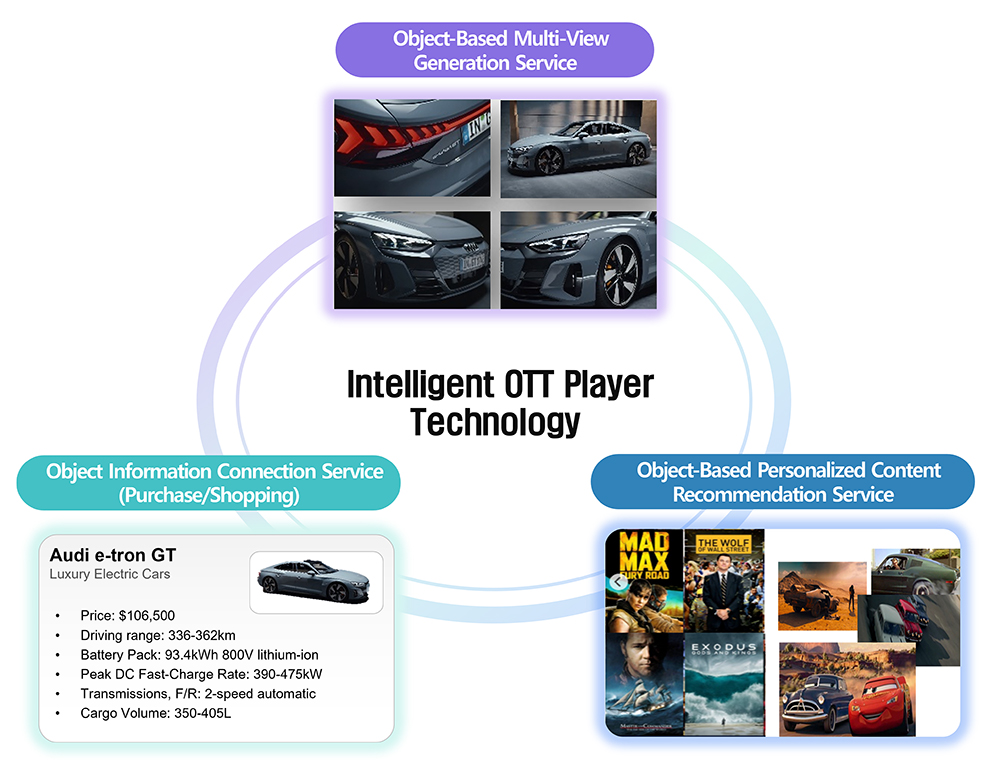 Concept diagram of Intelligent Multi-View OTT Player Technology
Concept diagram of Intelligent Multi-View OTT Player Technology
ETRI’s intelligent OTT player technology that provides Multi-View experience of objects on screen uses AI to detect and analyze objects of interest to viewers. It provides detailed information about the analyzed object, and can generate a rotated left-right multi-view image when the viewer touches the object. This enables a variety of additional information services such as shopping, purchase links, and advertisement. It also provides increased personalization and immersion by applying object-based content recommendation technology in addition to existing viewing history-based recommendations.
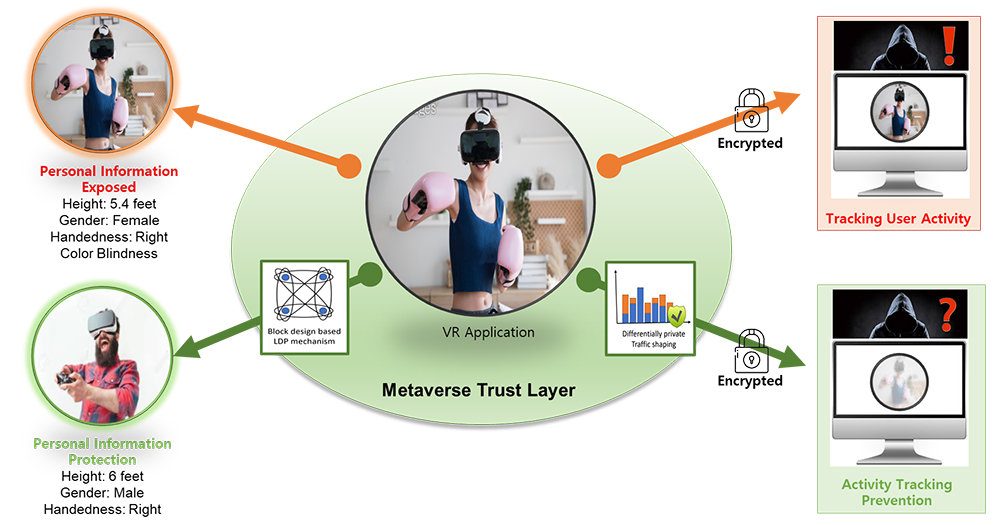 How the Metaverse Trust Layer Protects Users from Privacy Risks
How the Metaverse Trust Layer Protects Users from Privacy Risks
The metaverse trust layer protects user privacy by preventing the identification of personal information and actively blocking potential adversaries in the network from tracking metaverse activities. This ensures that users can enjoy a secure and immersive metaverse experience, free from concerns about privacy breaches or activity monitoring.
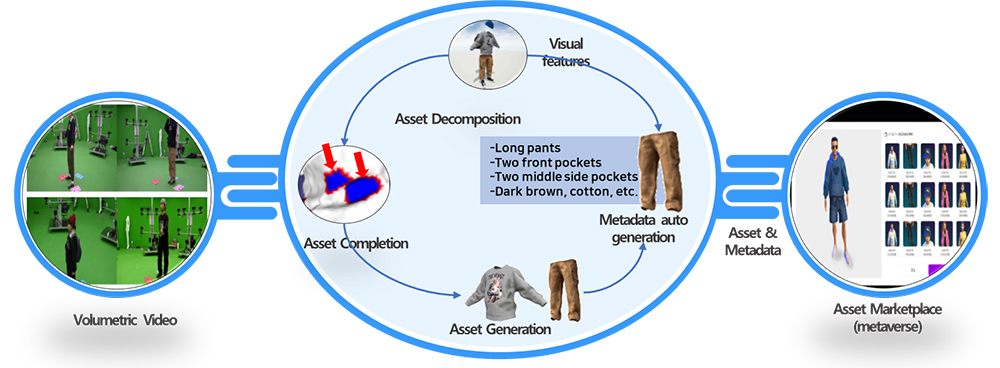 Overview of User Sovereignty Volumetric Asset Creation and Trading Technology
Overview of User Sovereignty Volumetric Asset Creation and Trading Technology
User sovereignty volumetric asset creation and trading technology enables volumetric video to be utilized as digital assets. Users can convert their owned physical objects into 3D digital assets and trade them in metaverse marketplaces. Core technologies include object decomposition from point cloud data, the completion of full 3D assets, automatic metadata generation, and integration with metaverse marketplaces.
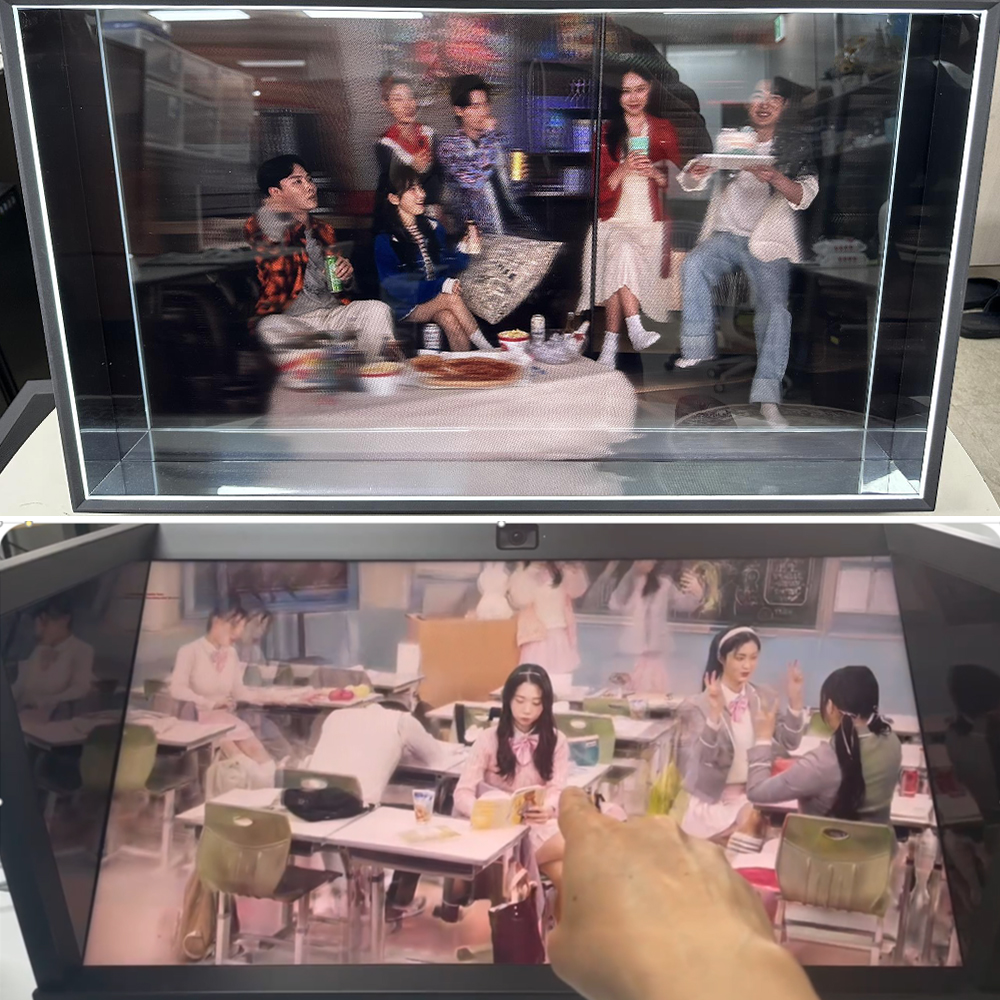 Immersive video spatial computing technology for ultra-realistic metaverse services
Immersive video spatial computing technology for ultra-realistic metaverse services Immersive video spatial computing technology for ultra-realistic metaverse services constructs 3D spaces that appear just as the real world. It provides an immersive experience on various venues including concerts or sports events based on 3D spatial reconstruction and volume rendering technology. Especially, users can move freely in the generated 3D space to feel a new sense of immersion.
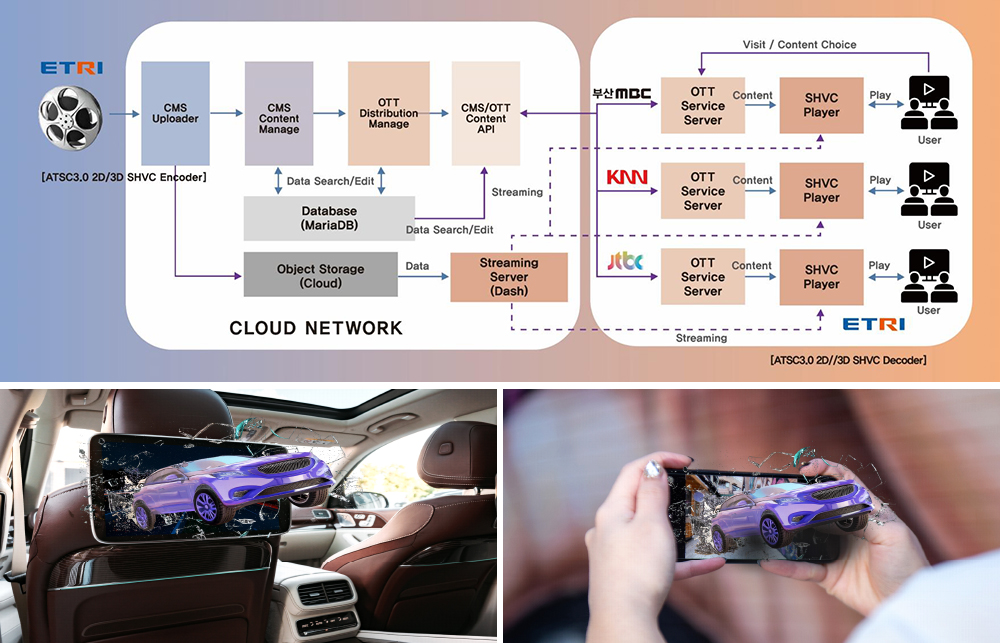 Development of user-selectable UHD stereoscopic media service technology
Development of user-selectable UHD stereoscopic media service technology
User-selectable UHD stereoscopic media service technology is a technology that allows users to freely choose between 2D and 3D in an OTT-based ATSC 3.0 environment. Users can switch viewing modes in context without creating 3D content. VR and AR capabilities are also available for a more immersive viewing experience.
“The AI-powered media technologies presented by ETRI at NAB 2025 represent a significant technological breakthrough for the future of the broadcasting and media industry,” said Curtis LeGeyt, president of the National Association of Broadcasters (NAB).
The technology was developed with the support of the Ministry of Science and ICT for the research projects of △OTT player intelligence technology that provides Multi-View △blockchain convergence technology for the realization of trust metaverse △development of photo-realistic stereoscopic spatial computing technology for hyper-realistic metaverse service △development of original technology for hyper-realistic stereoscopic media and content.
Namkyung Lee, Director
Media Intelligence Research Section
(+82-42-860-1148, nklee@etri.re.kr)
- Minimum QoS guarantee and dual connectivity technology compatible... opens 5G private network market opportunities
- Selected as a representative achievement of ETRI and recognized for excellence in the global market... commercialization in sight
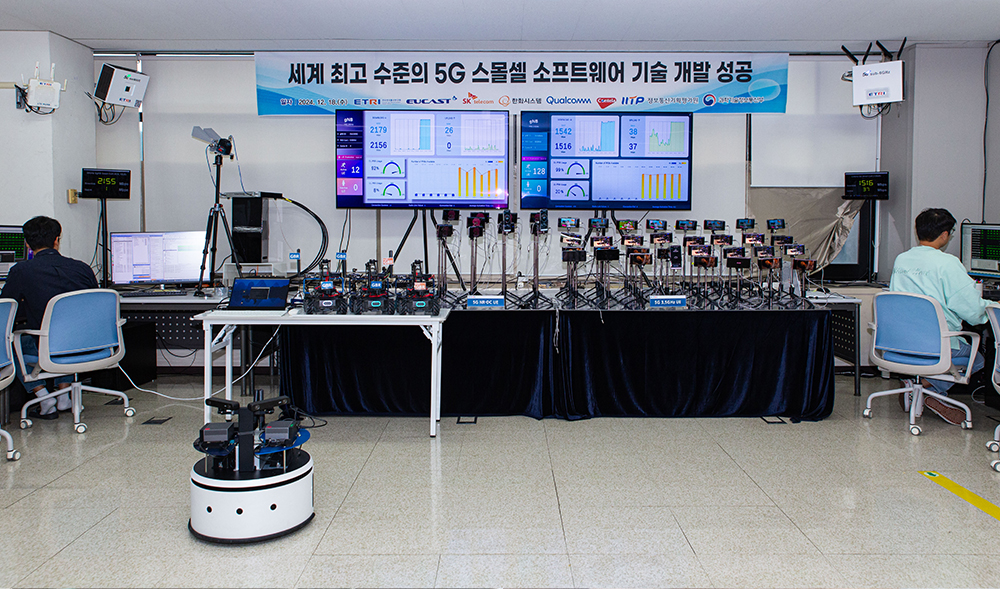 5G Small Cell Software Test Environment
5G Small Cell Software Test Environment
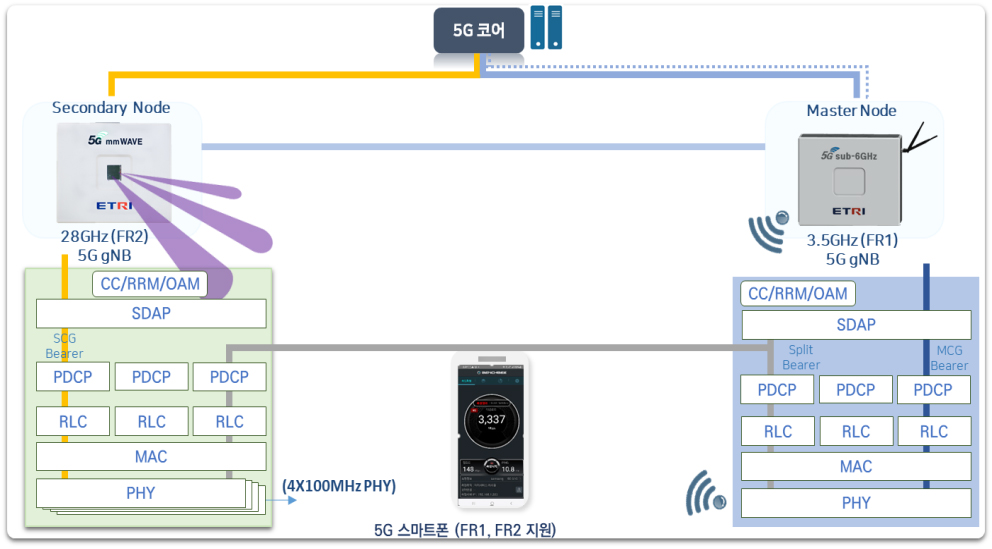 Concept diagram of 5G Small Cell Dual Connectivity
Concept diagram of 5G Small Cell Dual Connectivity
Korean researchers have succeeded in developing 5G small cell base station1) software that provides up to 4 Gbps while ensuring high-quality user experience. This level of traffic performance is competitive with global cutting-edge technology and the outcome is expected to be widely deployed in 5G private networks2) that require high quality of service (QoS), such as smart manufacturing, smart factories, and defense networks.
ETRI announced that it has developed a 5G small cell base station software capable of supporting 4 Gbps downlink throughput and quality of service (QoS) assurance3) and dual connectivity4). The development project was jointly conducted through research partnership with Eucast, Qualcomm, Contela, Hanwha Systems, and SK Telecom.
In the commercialization scenario of this technology, a single palm-sized small cell base station is expected to be sufficient to provide 40 Mbps traffic to 100 handheld devices even in an overly crowded unfavorable wireless environment.
While traditional cellular base stations cover macro areas, small cells are characterized by their ability to provide high-speed, high-quality data services in small designated areas. Small cell technology is a key enabler for uninterrupted, ultra-high-speed communication in indoor environments.
In particular, the novel minimum QoS guarantee technology offers the sustainability of QoS-sensitive services such as video calls, live streaming, and remote robot control for a large number of concurrent users.
1) Small cell base station: Smaller than a macro base station, it is characterized by low output and narrow coverage, and is installable under various deployment scenarios, such as for home use, in-building use, urban hotspot use, and outdoor use. Since fewer subscribers are supported by a single small cell base station than by a macro base station, the per-user data rate can be significantly higher and installation is relatively simple.
2) 5G private network: Unlike mobile networks, which mandate national territory scale frequency band license, a private network allows companies to obtain and use an exclusive license at a low cost for a specific purpose within a certain area. In Korea, the 4.7 GHz band and 28 GHz band are assigned as 5G private network frequencies in 2022.
3) Quality of service (QoS) assurance: It is a technology that guarantees the transmission speed and latency required by users, and enables mobile communication base stations to ensure differentiated service quality through radio resource scheduling algorithms.
4) Dual connectivity: A technology that allows a device to simultaneously connect to two base stations (e.g., LTE base station + 5G base station, 5G Sub-6GHz base station + mmWave base station). It can be used in improvement of data rate, latency, coverage expansion, and handover stability enhancement.
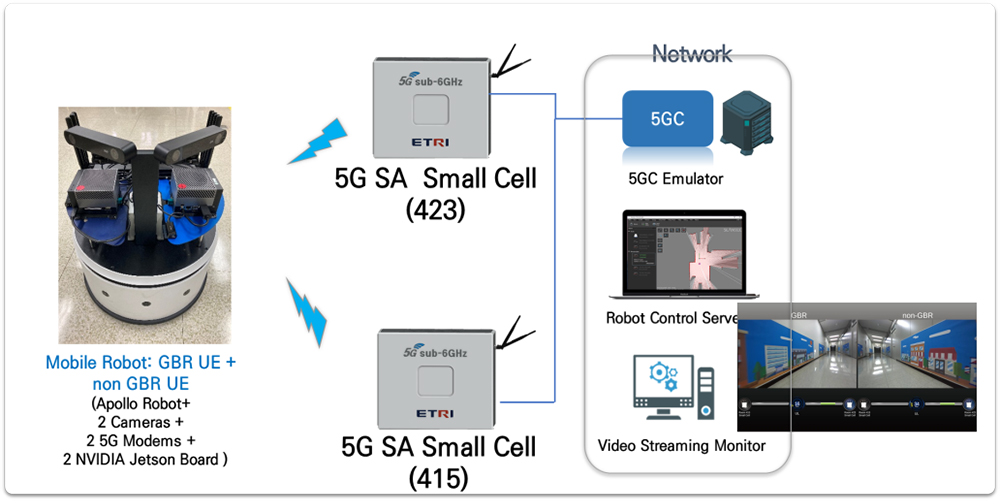 5G Small Cell Uplink High Definition Streaming Service
5G Small Cell Uplink High Definition Streaming Service
In this research, ETRI applied dual connectivity technology to enable the coherent deployment of 5G millimeter wave (mmWave)5) small cells as well. This dualized traffic path can be exploited to enhance data rate in 5G private networks, or to enhance network reliability as well.
The research outcomes are applicable to a wide range of industries and services, beyond simply increasing data rates. The researchers emphasized that this achievement will promote the broader utilization of 5G Standalone (SA)6) services.
In addition to the QoS assurance technology, ETRI presented several key outcomes of this project, including ▲advanced dual connectivity technology ▲4x4 multiple input/output (MIMO)7) support in Sub-6GHz bands8) ▲small cell network autonomous healing technology ▲user location-based energy saving technology.
The national contribution of this project ranges from delivering benefits to regular users to facilitating relevant domestic industry to equip cost competitiveness in the global market.
ETRI has independently developed commercial-grade small cell communication software through international collaborative research with Qualcomm, which is a leading player in 5G small cell modem technology. In December of last year, ETRI completed interoperability verification with commercially available 5G devices in Korea and abroad, enabling immediate commercialization.
The project has completed technology transfer to several domestic enterprises. It is expected to provide a shortcut for those companies to launch business models based on well-proven technical foundation and significantly cost-competitive solutions. The technology has also been validated for compatibility with a wide range of 5G modems, well beyond just Qualcomm modems.
Baek Yong-Soon, Senior Vice President of ETRI’s Terrestrial & Non-Terrestrial Integrated Telecommunications Research Laboratory, said, “The development of 5G small cell software has enhanced the domestic industrial competitiveness of mobile communication technology. This technology has foundational characteristics and can be expanded in various branches of next-generation mobile communication technologies such as 6G and Open RAN.”
Na Jee-Hyeon, Director of ETRI’s Intelligent RAN SW Research Section, said, “The advancement of 5G small cell software technology enables us to customize the quality of service for users, and the availability of dual connectivity technology makes it easier to provide higher data rates. If this technology is utilized in a 5G private network, a variety of potential service applications can be discovered.”
ETRI explained that this technology can be applied in the future for use cases such as ▲video calls that require guaranteed QoS ▲mobile broadcasting that ensures high quality ▲high-definition CCTV services ▲smart factories for robot control messages.
ETRI’s recent achievements have been highly recognized both domestically and internationally. In 2024, it was selected as the best project in the industry promotion field among the top 10 representative achievements of ETRI, and in 2023, it was also nominated among the top 100 national achievements. In addition, it was recognized internationally as the Best Software at the Small Cell World Summit Forum (SCF) Awards 20239) held in London, UK in May 2023.
Through this project the researchers have published 11 SCI-indexed papers, filed 103 domestic and international patent applications, obtained 9 registrations, contributed to 17 international standards, and completed 10 technology transfers.
Currently, domestic companies that have received the technology transfer are launching and commercializing small cell products in the 3.4 GHz band (n78) as well as the 4.7 GHz band (n79), which is the frequency band for 5G private networks in Korea. They are targeting 5G private network domestic markets such as 5G smart manufacturing and defense networks, and are expanding the business to South America and Japan.
The research was conducted as part of the ‘5G NR-based Intelligent Open Small Cell Technology Development’ project, which has been supported by the Ministry of Science and ICT and the Institute of Information & Communications Technology Planning & Evaluation (IITP) since 2018.
5) Millimeter wave (mmWave): High-band frequencies above 24 GHz, the 28 GHz band is allocated as the 5G frequency band in Korea
6) Standalone (SA): 5G standalone mode, a 5G network that operates solely on 5G without relying on LTE, consisting of a 5G-dedicated core and a 5G standalone base station
7) 4x4 multi-input and multi-output (MIMO): A wireless communication technology that uses four transmitting and four receiving antennas, which can transmit four data streams simultaneously to increase the speed of data transmission and reception
8) Sub-6GHz band: Frequencies below the 7.125 GHz band, in Korea, 3.5GHz band is allocated to mobile carriers and 4.7GHz band is allocated for 5G specialized networks
9) Small Cell World Summit Forum (SCF) Awards 2023: The Small Cell World Summit (SCWS), held annually in May in London, UK, recognizes organizations with outstanding technologies
Jeehyeon Na, Director
Intelligent RAN SW Research Section
(+82-42-860-5408, jhna@etri.re.kr)